![]()
![]()
![]()
Use LEFT and RIGHT arrow keys to navigate between flashcards;
Use UP and DOWN arrow keys to flip the card;
H to show hint;
A reads text to speech;
61 Cards in this Set
- Front
- Back
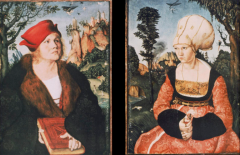
|
Dr. Johannes Cuspinian and Anna Cuspinian- Lucas Cranach the Elder, 1502, oil |
|
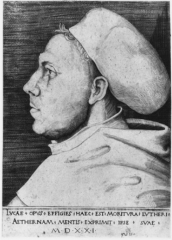
|
Martin Luther- Lucas Cranach the Elder, 1521, engraving · Centre of the protestant church · Engraving is reproducible and can be distributed across the world · More about the writing rather than about his portrait, means “his writing is showing all that is immortal” |
|
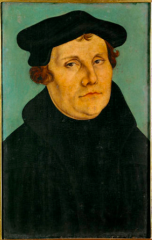
|
Martin Luther- Lucas Cranach the Elder, 1529, oil · Centre of the protestant church · More about the writing rather than about his portrait, means “his writing is showing all that is immortal” |
|
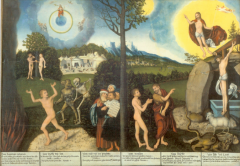
|
Allegory of Law and Grace- Lucas Cranach the Elder, 1529, oil |
|
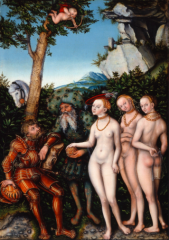
|
Judgementof Paris- Lucas Cranach the Elder, 1530, oil |
|
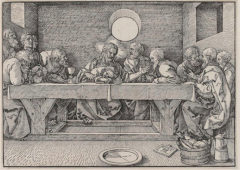
|
Last Supper- Albrecht Durer, 1523, woodcut |
|
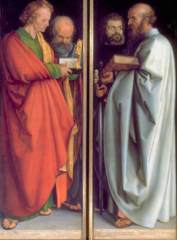
|
Four Apostles- Albrecht Durer, 1526, oil |
|
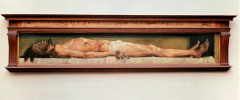
|
Christ in the Tomb- Hans Holbein the Younger,1521, oil · Originally was a predella (painting that is astep below a larger panel) · Very real. Shows skin turning green, slightlyparted lips, and eyes rolling to the back of his head. Theatrical scene · In the early 1520’s Switzerland was rocked withdeep unrest between protestants and Catholics. Large riots |
|

|
Erasmus- Hans Holbein the Younger, 1523-24,oil · Claimed him as their great champion· Does his books go on the list of prohibitedbooks or not? · Not a traditional scholar in his study · Completely absorbed in the painting, viewer is peeringover the shoulder watching him write · Sharpness of his quill is mimicked by thesharpness of his eyes |
|
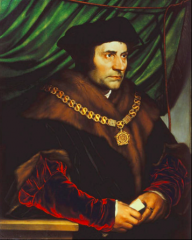
|
Sir Thomas More- Hans Holbein the Younger, 1527, oil · Author of utopia o Here there was no such thing as money, everyonetook a turn to do things · Wrote this work as a critique of money grabbedgreed of society. · More became the lord chancellor of England· When he failed to conceive an heir, Henry the 8thclaimed himself head of another church, more did not want to give up king ofEngland and was then thrown into prison and Henry the 8th becameleader of the country · Chain incorporates the S of Lancaster, and thetutor rose |
|
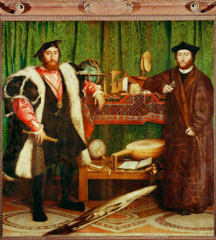
|
The Ambassadors (Jean de Dinteville and Bishop Georges de Selves)- Hans Holbein the Younger, 1535, oil · Jean- very elaborate, highly refined features, Bishop- subtly elegant · Objects on the table also characterize them.Broken string on the lute and in front of the lute there is a Lutheran hymnbook. · Skull on the floor. Must look at it from aparticularly weird angle. Very realistic from the weird angle · Imagery made by Holbein that makes you wonderabout humility. |
|
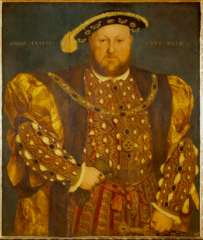
|
Portrait of King Henry VIII- Hans Holbein the Younger, 1539-40, oil · Bulky garments that take up the whole frame · Henry is dead on straight- frontal face ofmajesty. · needed to find another wife for Henry to ensuresuccession for his line |
|
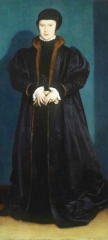
|
Portrait of Christina of Denmark- Hans Holbein the Younger, 1538, oil · Bachelorette · Related to almost every European house · Sent his court artist (Holbein) to paint her · Very white skin as an upper class woman shouldhave · Henry asked Christina to marry him. Christinaturned him down for poticial reasons |
|
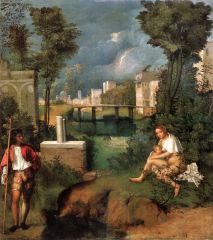
|
The Tempest- Giorgione, 1505-1510, oil · Tempest or storm · Painting shows nude woman nursing a baby · Mixing of all four elements in the painting · X-ray of the painting, certain pigments show upbetter. Original in place of the man, there was another naked woman |
|
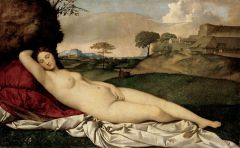
|
Sleeping Venus- Giorgione (finished by Titian), 1507-1510, oil · Compared to the famous painting of venus,similar left hand covering genitals. · Passive venus, male fantasy · Colour was associated with women, colour is whatis making the painting inviting, alluring, and sexual |
|

|
Sacred and Profane Love- Titian, 1514, oil · Woman dressed in prestigious white fabric · Seems to have come down to the fountain, we knowits down by the way her fabric is flowing · Varied landscapes in the background- high roadvs low road. · Was it the wedding of Niccolo Aurelio and LauraBagarotto? |
|
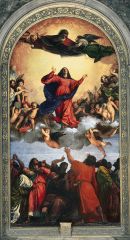
|
Assumption of the Virgin- Titian, 1516-1518, oil · Muscular figures reaching up to mary · Mary is a big person but seems to be raised upand floating mid air in glory. Babies pushing up on the clouds as she rises. · Last tangible connection to the divine (mary)when she died. · God the father as a critique of Michelangelo.Face is like a flickering flame |
|
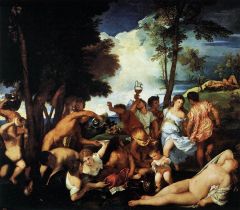
|
Bacchanal of the Andrians- Titian, 1522-1524, oil · Bacchus comes in triumph is his victories inIndia and leaps from his chariot falling in love with Ariadne here. · Ariadne’s constellation can be found in the skyeven though it is a bring sunny day · Laocoon (statue in the Vatican) man is coveredin snakes |
|

|
The Pesaro Altarpiece- Titian, 1519-1526, oil · Commissioned by Jacopo Pesaro, he is actuallycaptured in the painting · The location of the painting was importantbecause when walking into the church the virgin seems to be turned towards you.She is addressing the viewer and a relationship is created · The column in the back mimic the column that canbe found within the church. Implied huge scale. Cut off the building andcontinue with the immeasurable columns. · Young boy is looking out towards us engaging usand pulling us into this painting |
|
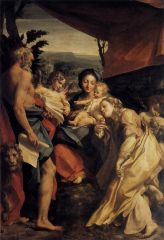
|
Madonna and Child with St. Jerome and the Magdalene- Correggio, 1523, oil · There is a focus on landscape. Makes the sittersmore humble and earthly. May be a more appropriate scene for passion · There is a sweet loveliness of the scene, butthere is an angel holding up a large book for Jesus to read. There is also adarkness of the coming passion · Mary Magdalene is embracing the foot of Jesusand it is a reference to Mary Magdalene washing Jesus’ feet. Other angelsholding the Ointment in the background. |
|
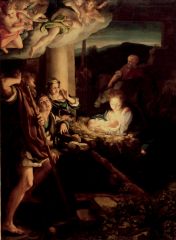
|
Adoration of the Shepherds- Correggio, 1522, oil · Light is coming from the baby Jesus. He isglowing and shedding light on Mary, the shepherds, and the angels above. · Joseph shown as an old man to show that he isnot the biological father · The viewer is not immediately leaning over thebaby |
|
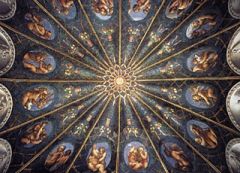
|
Camera di San Paolo- Correggio, 1519, fresco · Wealthy young ladies would join nunneries likethis to gain an independence and an education · Remind you of a Michelangelo from the sitters onthe Sistine ceiling · Mixing of pagean and Christian. · Nudity in Christian context. These works werepolitical and they ment something to their viewers. · Vision of the end of days when everyone standsinfront of their maker nude |
|
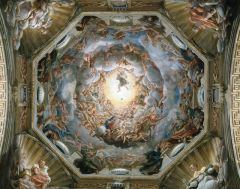
|
Assumption of the Virgin- Correggio, 1526-1530, fresco |
|
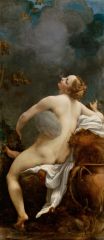
|
Juniper and Io- Correggio, 1530s, oil · Cloud reaching down and around her kissing her. Moment of sensual abandon |
|
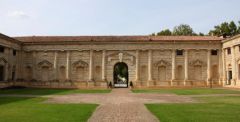
|
Courtyard, Palazzo Te, Mantua- Giulio Romano, 1527-1534 · Each room is decorated differently. Gives you asense of how elite and mysterious the images are supposed to be Classical Architecture- playing with thestandard ideas that were thought to be the apex of architecture. Breaking therules. · Playing with the idea of architecture that isnot quite right. Not all stones are the same size or have the correct placement · It is actually stucco one top of the brick, notactually rocks. · Key stone in the arch does not fit quite right. · Trigylph sunken lower · Was made for a pleasure palace. |
|
|
not sure |
Sala dei Giganti (Palazzo Te)- Giulio Romano, 1530-1532, fresco · Portraits of the duke’s horses rather than agrand image · Quite a few more animals- adding an imperialmenagerie. Elaborately crafted. Art for the sake of art |
|
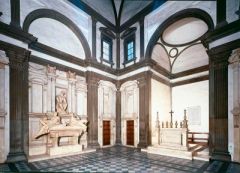
|
Medici Chapel (San Lorenzo, Florence)- Michelangelo, 1519-1534 · Chapel for the Medici’s · Built another story, playing with proportion Classical Architecture- playing with thestandard ideas that were thought to be the apex of architecture. Breaking therules. |
|
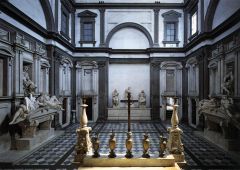
|
Medici Chapel (San Lorenzo, Florence)- Michelangelo, 1519-1534 The Architecture of the Chapel (interior) · Over life-sized sculptures · Making a mirror image, a chapel on the otherside · More windows which lets in more light · Architectural forms seem to be |
|
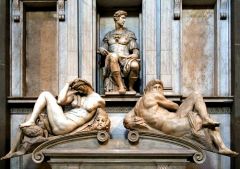
|
Medici Chapel (San Lorenzo, Florence)- Michelangelo, 1519-1534 Tomb of Giuliano de' Medici (Giuliano, night and day) marble · Hyper elegant, hyper refined · Tiny heads and muscular bodies · Exaggerated figures · Went unfinished · Not possible pose · Owl representing night or nocturnal · She is sleeping, but in a very difficultposition |
|
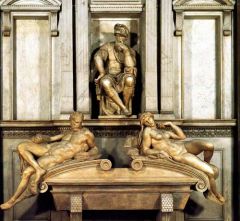
|
Medici Chapel (San Lorenzo, Florence)- Michelangelo, 1519-1534 Tomb of Lorenzo de' Medici (Lorenzo, dusk, and dawn) marble · Hyper elegant, hyper refined · Tiny heads and muscular bodies · Exaggerated figures · Old man slumping of his mantle · Moment of transition where there is still lightin the sky but started to fall · Waking up and starting day · Young woman |
|
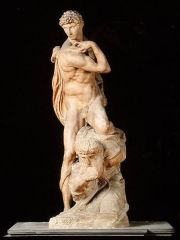
|
Victory- Michelangelo, 1527-1528, marble · Almost doesn’t know that there was a man underneathhim · Intended to pope Julius’s tomb |
|
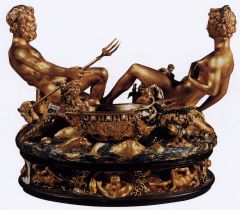
|
Salt Cellar- Benvenuto Cellini, 1540-1543, solid gold with enamel and jewels · Wrote his own autobiography. Gives a vivid anddeeply disturbing to be a meglomanic and live in 16th century Italy.Violence he committed against men and women. Sexual feats. Writes about otherartists. Hard to take him seriously as a source · Idea that this man according to his own account,should see a halo over his head after having committed many crimes. Its not allhot air, there is substance there. · Man on the bottom meant to look like day · Saying “Salt in your head” literally salt inCellini’s head. You are picking his brains |
|
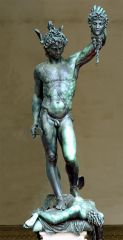
|
Perseus- Benvenuto Cellini, 1545-1554, bronze (with a marble base) · It was a power grab to move the statue. He wasliterally embodying the government by moving · Perseus- shown in a moment of absolute triumphafter cutting off the head of medusa and standing on her body. · Perseus and David have very similar poses. |
|
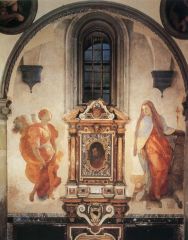
|
Annunciation- Jacopo Pontormo, 1525-1528, fresco · The virgin mary is in a corkscrew pose. Twistingcompletely around but is still very graceful |
|

|
Entombment- Jacopo Pontormo, 1525-1528, oil · Wait for jesus’s body to be taken away to thetomb. And agonizing moment for Mary. · Weirdly beautiful and kind of unnatural. Wearingpastel colours. Light and bright for one of the darkest days · There is one dark cloud. There is no horizonline and it seems the ground is tilted up |
|
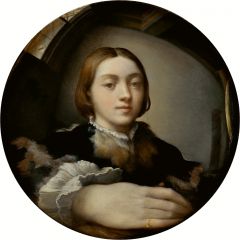
|
Self-Portrait in Convex Mirror- Parmigianino, 1524, oil (on convex panel) · Wants to take on the mantle of Raphael · Only had curved mirrors. Shows himself as onlyin a curved mirror · Looks like a very young boy who resemblesRaphael |
|
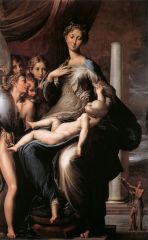
|
Madonna of the Long Neck- Parmigianino, 1534, oil Left unfinished at his death in 1540 · Weird scale. Little man in the background. · Hyper elegant leg being displayed. · Not elegant depiction of the baby |
|

|
Eleonora of Toledo and her son Giovanni- Bronzino, 1545, oil |
|
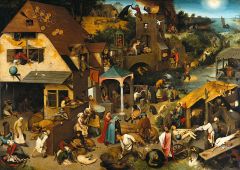
|
Netherlandish Proverbs- Pieter Brugel the Elder, 1559, oil · Man leaning out the window, peeing on the signbeneath is that is in the shape of a moon · Woman who is deceiving her husband and isputting a blue cloak over him (another expression for pulling the wool over hiseyes) so that he cant see her unfaithfulness. He is old and she is young. · Religious figure (Jesus) who is sitting right inthe middle of the composition and the Monk is not properly worshiping Jesus,but instead putting a fake beard on him trying to gussy him up. |
|
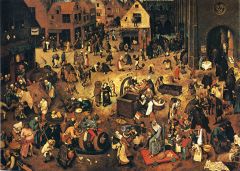
|
The Battle between Carnival and Lent- Pieter Brugel the Elder, 1559, oil · Carnival was a time where people went crazybefore the somber time of lent. Allowed you to left off steam that the churchsupported · There is a battle between people celebratingCarnival and those supporting Lent |
|
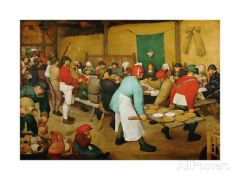
|
The Wedding Feast- Pieter Brugel the Elder, 1568, oil · Looks more like an Italian painting. Figuresthat are largest and closest to us are not the main focus of the painting · Bride is somewhat being mocked. The assumedGroom is caught at a awkward moment of putting food in his mouth. Trying to geta much as he can. · There are more and more people shoving to get into sensely grab food. Animalistic desire to grab food. |
|
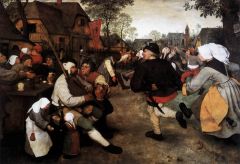
|
Peasant Dance- Pieter Brugel the Elder, 1568, oil · Creating an image for a noble person to createan image of the beast like people · Almost like going to the zoo to see these beastsand understand how they behave. |
|
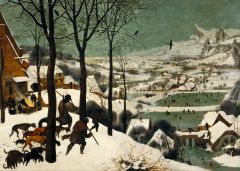
|
Hunters in the Snow- Pieter Brugel the Elder, 1565, oil · Snowy landscape- Europe was going through a bitof an ice age at this point in time · Group of hunters heading out with their huntingdogs. Skaters in the background. There is no dramatic subject. Ie- not showinga big hunt for the animals, but just showing the hunters going out. · The landscape is majestic. The trees almost looksoft. Snow gathers on the closer branches |
|
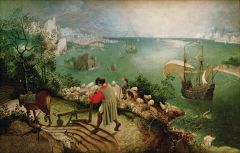
|
Fall of Icarus- Pieter Brugel the Elder, 1555-1556, oil · Icarus show how Dedalus and Icarus were trapped.Dedalus invented a marvellous way to escape. Created wings that were made withreal wing and head together by wax. The wings worked, Icarus flew too high andflew too close to the sky and the wings melted and he fell to his death in theocean. Show the limitations of manMan must fail, but the worst part is that no onecares. Not an important failure. |
|
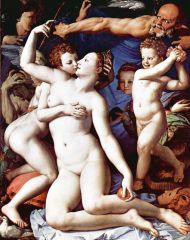
|
Allegory of Love- Agnolo Bronzino, 1545, oil · Made my a man, for a man, to be given to anotherman (king francis the first) · Little bit of sex but not too explicit · Venus, holding the golden apple sharing a veryintimate embrace with her son cupid Open mouth kiss between mother and son · Loving embrace might not be without it’s darkside. Baby has a thorn through his foot but he is still laughing and throwingroses. All pleasure comes with pain. · Older gapped tooth woman holding her head inagony. Make venus look ever more lovely. · This painting can be read morally, but yet thereare points of jealously and anger. |
|

|
Crossing of the Red Sea- Agnolo Bronzino, 1540-1545, fresco · Sign that the jews are the protected people ofgod. In the water there is many members of the pharaoh’s army · Moses has the beams of light coming from hishead, look like horns · Young man’s back has a large presence in theimage |
|
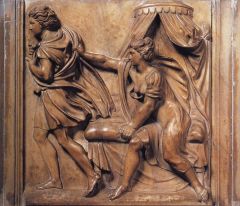
|
Joseph and Potiphar's Wife- Properzia de' Rossi, 1520s, marble · Artist needs to be learning to create highcalibre pieces of art. Women have a hard time getting their education · Shows a scene from Hebrew scripture. Shows theattempted rape of a man by a noble woman · Vasari were placing great emphasis on the small figures that they has done and its is surprising that a woman could have suchgood manual skill. Thinks that she cannot be a creative thinker |
|
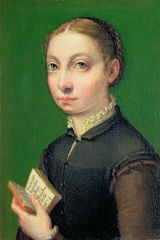
|
Self-Portrait with a Book- Sofonisba Anguissola, 1555-1560, oil · In order to have your daughters be married youhad to have lots of money saved · All of his daughters learned trades instead, andthey taught each other the things that they knew· Double marvel- its an amazing painting and thata woman was the one who made it |
|
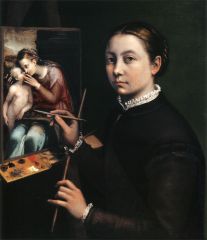
|
Self-Portrait with an Easel- Sofonisba Anguissola. 1555-1560, oil · In order to have your daughters be married you had to have lots of money saved · All of his daughters learned trades instead, and they taught each other the things that they knew · Double marvel- its an amazing painting and that a woman was the one who made it |
|

|
Bernardino Campi painting Sofonisba Anguissola- Sofonisba Anguissola, 1550's, oil · Her master painting herself looking much morefeminine · Male master created her and that is all she reallyis. · Could be an ironic gesture- ultimately it is allher creation but you see the possibility that she is mastering the master · Does not look like her other self portraits |
|
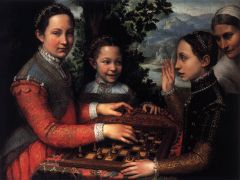
|
The Artist's Three Sisters Playing Chess, Sofonisba Anguissola, 1555, oil · Her sisters are wearing much richer garb thanshe is · The girls are smart and educated and we knowthat through them playing chess. Middle sister is ready to pounce on themistake that her sister is about to make and the youngest sister is gigglingknowing that her middle sister is right |
|
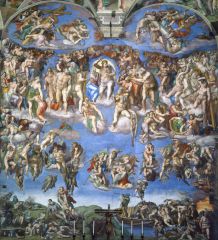
|
Last Judgement- Michelangelo, 1536-1541, fresco · The piece had to be censored. Censored to · Jesus had one hand up and on hand downsignifying sending some up to heaven and others down to hell · Fore boding of what would happen if you were togo against the catholic church · Michelangelo’s self portrait |
|
|
not sure |
Crucifixion of St. Peter- Michelangelo, 1545-1550, fresco |
|
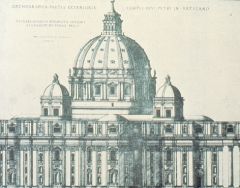
|
St. Peter's, Rome (Rear View with Giant Order Pilasters and the Dome)- Michelangelo, 1546-1564 |
|
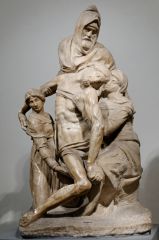
|
Pieta (with Nicodemus and St. Mary Magdalene)- Michelangelo, before 1555, marble |
|
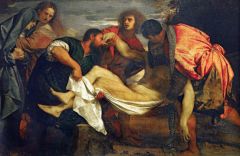
|
Entombment- Titian, 1520s, oil · Titian’s style changed over the course of hiscareer · Relative importance of design and colour · Moment after the pieta (laying in his motherlap) · Colour and light are being used to bring thisscene to life · Mary Magdalene is in anguish to see the death ofJesus |
|
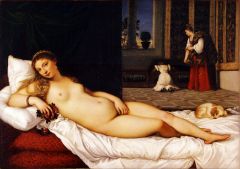
|
Venus of Urbino- Titian, 1538, oil · Not clear who the woman is, is she venus? · She is awake in the portrait compared to thesleeping venus · A high class prostitute? · Marital virtue? Showing the dog and the women inthe back |
|
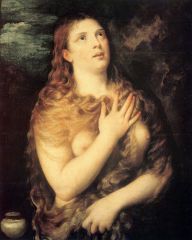
|
St. Mary Magdalene- Titian, 1530s, oil · Thought to have committed terrible sins(prostitution) · Privileged to first witness to the resurrection · May have preached for a while. Then went out andlived in France to live in penitence. |
|

|
Rape of Europa- Titian, 1559-1560, oil · Painted of King Philip II of Spain- very Christian · Painted much more roughly, not carefullypolished · If you get up close, it looks like nothing atall, but if you are far away it all comes together · Rape at this time meant kidnapping, not necessarilyrape. · Moment when Jupiter wants to have sex withEuropa · Foundation myth of Europe · Is Titian a feminist or are the painting are aform of visual rape |
|

|
Pieta- Titian, 1579 (unfinished but Titian died), oil · This was painting was going to be at his owntomb. Wanted to be buring in Ferrari where he had his first painting hung · Christ has layers of rough strains that arenoticabley untouched. · Offer small paintings of your self praying sothat you could give it to the person to should · Very similar to michelangleo |
|
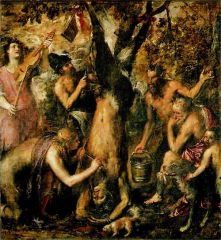
|
Flaying of Marsyas- Titian, 1575-1576, oil · Appollo himself who has the knife and isexpertly slicing the saytars body. · Saytar’s eyes are open and blood is pouring down · Lap dog is licking up the blood · The only figure that is distanced from theviolence is King Mitas |

